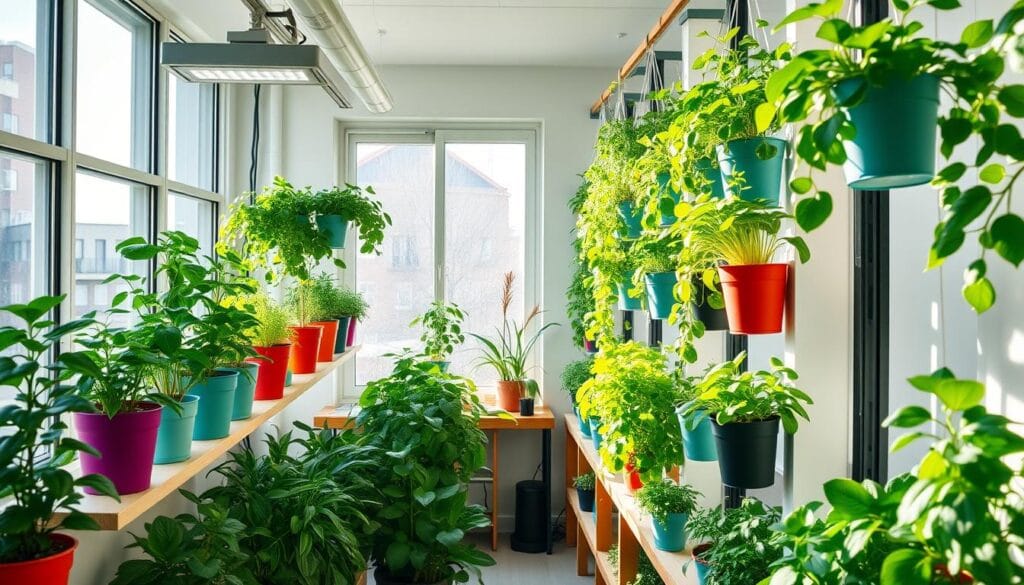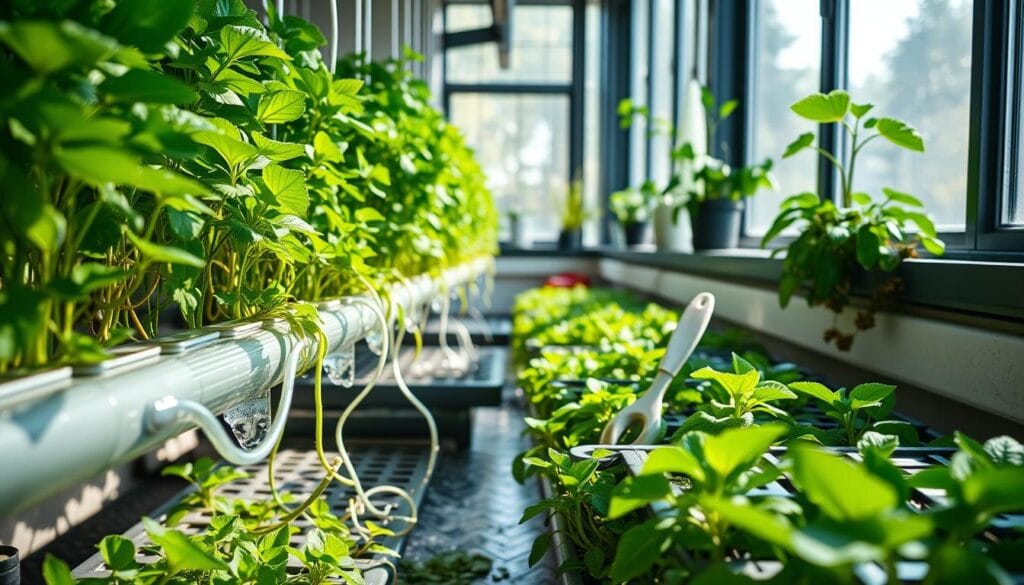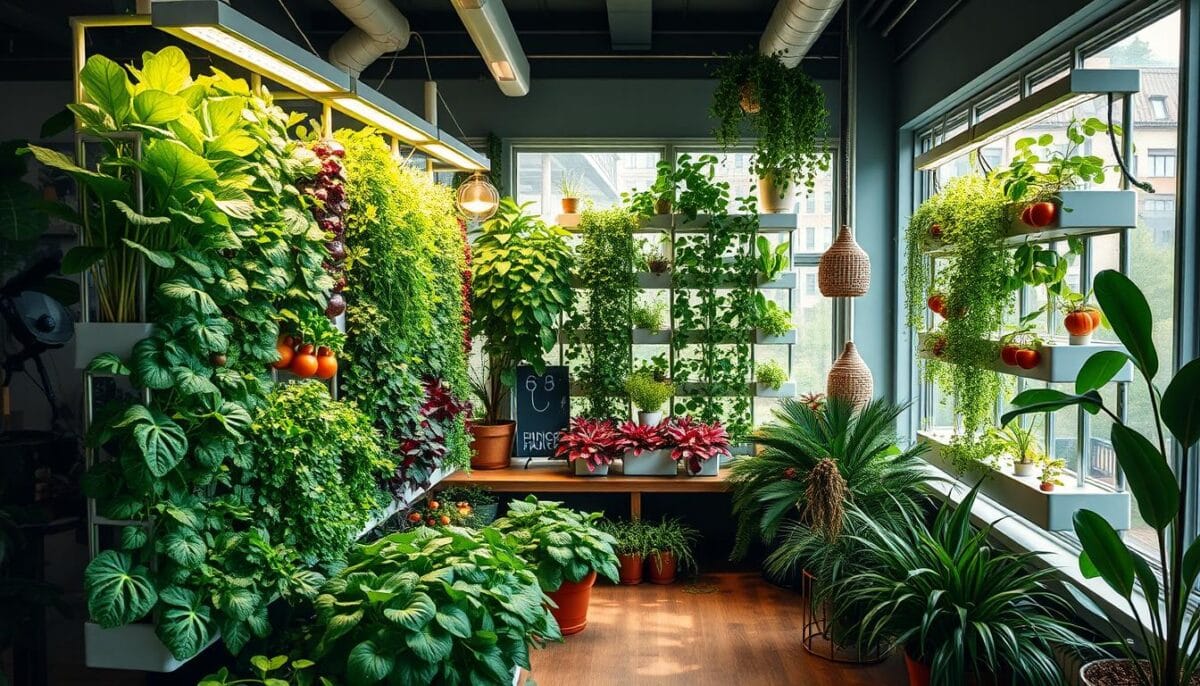Hydroponic gardening is a way to grow plants without soil. Instead, plants are fed by a nutrient-rich water solution. This method leads to bigger harvests, quicker growth, and fewer problems with pests and diseases.
Hydroponic gardens are perfect for indoor spaces. They’re ideal for people living in apartments or those who want to grow plants all year in a small area. With the right setup and care, you can have a lush indoor garden using hydroponics.
Key Takeaways
- Hydroponic gardening offers benefits like larger harvests and faster growth.
- Hydroponic gardens can be set up indoors, making them suitable for small spaces.
- Proper setup and maintenance are crucial for a thriving indoor hydroponic garden.
- Hydroponic systems come in different types, including wick, water culture, and ebb and flow.
- Hydroponic gardening involves growing plants in nutrient-rich water, without soil.
Introduction to Hydroponic Gardening
Imagine growing your own fresh produce all year, no matter the weather. This is what hydroponic gardening offers. It’s a soil-free way to grow plants, loved by home gardeners and urban farmers.
What is Hydroponics?
Hydroponics means growing plants without soil. Roots soak in a nutrient-rich water solution or sit in a medium like perlite. This method lets plants get nutrients directly from water, promoting fast growth and high yields.
Benefits of Hydroponic Gardening
Hydroponic gardening has many benefits:
- It boosts productivity: Hydroponic systems can grow up to 3,400 plants a year. Each Flex Farm system can harvest over 394 pounds of produce yearly.
- It saves water: Hydroponics uses up to 90% less water than traditional gardening.
- It controls pests and diseases: Soil-borne problems are less common in hydroponics, making plants healthier and crops better.
- It allows year-round growing: Indoor hydroponic gardens let you grow produce anytime, weather permitting.
Thanks to tech like the Flex Farm, hydroponic gardening is becoming easier and more impactful. It helps build strong local food systems and brings fresh, nutritious produce right to your home.
“Hydroponics is a game-changing technology that can revolutionize the way we grow and access fresh, local food. By allowing us to cultivate plants without soil, it opens up a world of possibilities for urban and indoor farming.”
Choosing Plants for Your Hydroponic Garden
Starting a hydroponic garden means picking the right plants. Leafy greens and herbs are great for beginners. More experienced growers can try bigger, harder-to-grow crops.
Best Plants for Beginners
Novice hydroponic gardeners should consider these plants:
- Lettuce
- Kale
- Spinach
- Basil
- Parsley
- Cilantro
These plants love the hydroponic setup’s controlled, soil-free environment. They’re easy to grow and maintain, perfect for beginners.
Larger Crops for More Experienced Growers
As you get better, you can grow bigger, more challenging plants. These include:
- Tomatoes
- Peppers
- Strawberries
- Bok Choy
These crops need more care and specific conditions. But they’re rewarding for those with more experience.
Hydroponic gardening lets you grow many types of plants. Start with easy ones and add more as you get better. This way, you can make a productive hydroponic garden at home.
Types of Hydroponic Systems
There are various types of hydroponic systems available for home gardening. Each has its benefits and features. Knowing about these can help you pick the right one for your space, budget, and gardening dreams.
Wick System
The wick system is simple and easy to use. It uses a wick to pull water from a reservoir up to the roots of plants. It’s great for beginners or those with little space because it needs very little care.
Water Culture System
The water culture system, also called the “lettuce raft,” keeps roots in the nutrient solution. An air pump keeps the water aerated, giving plants the oxygen they need. It’s perfect for growing leafy greens and herbs.
Ebb and Flow System
The ebb and flow system fills the growing tray with nutrient solution, then drains it back into the reservoir. This cycle gives roots the nutrients and oxygen they need. It’s flexible and can grow many types of plants, from herbs to flowers.
“Exploring the different hydroponic systems can help you find the one that best fits your space, budget, and gardening goals.”
Every hydroponic system has its own benefits and things to consider. Knowing about wick, water culture, and ebb and flow systems can help you choose the best one. This way, you can create a thriving indoor garden that meets your needs.
Setting Up Your indoor garden
Starting an indoor hydroponic garden means thinking about space and light. You might have a small counter or a big setup. It’s key to measure well to pick the right fit for your space.
Space Considerations
Hydroponic systems come in all sizes, from small to big. Make sure to measure your space carefully. This ensures your chosen system fits well. You’ll need room for trays, nutrient tanks, and other gear like air pumps.
Lighting Requirements
Since hydroponic gardens use artificial light, getting the right light is vital. You need 15-20 hours of light daily. Use hydroponic lighting like fluorescent, LED, or HID lamps. The type and where you place them depends on your space.
| Lighting Type | Advantages | Considerations |
|---|---|---|
| Fluorescent | Energy-efficient, affordable | Shorter lifespan, lower light intensity |
| LED | High efficiency, long lifespan | Higher upfront cost |
| HID | Powerful light output | Higher energy consumption, generate more heat |
Plan your indoor gardening space and light needs well. This way, your hydroponic plants will do great.

Essential Components
To have a successful indoor hydroponic garden, you need to focus on a few key things. These include the water and nutrient solutions, air pumps, and aeration system. Each part is important for giving your plants the best growing conditions.
Water and Nutrient Solutions
The water in your hydroponic system should be filtered, not tap water. Keep the water temperature between 65-75°F and the pH level between 5.7-6.3. This helps your plants stay healthy. You can use liquid or powder nutrient solutions to give your plants the minerals and trace elements they need.
Air Pumps and Aeration
Air pumps and air stones are key for keeping the water aerated. Good aeration stops water from getting stale and makes sure plant roots get enough oxygen. It’s important to keep these parts in good working order to keep your garden healthy.
| Component | Importance | Recommended Specifications |
|---|---|---|
| Water | Provides hydration and nutrient delivery to plants | Filtered, 65-75°F, pH 5.7-6.3 |
| Nutrient Solutions | Supplies essential minerals and trace elements for plant growth | Liquid or powder formulas tailored to hydroponic systems |
| Air Pumps and Aeration | Ensures adequate oxygen supply to plant roots | Quiet, energy-efficient air pumps with air stones |
By managing the water, nutrient solutions, and aeration well, you’ll make a great environment for your plants. This will help them grow strong and reach their full potential.
Maintaining Your Hydroponic Garden
Keeping your hydroponic garden healthy and productive is crucial. This means checking the pH and nutrient levels often. Also, clean and refill the system regularly.
Monitoring pH and Nutrient Levels
The pH and nutrient balance are vital for your plants’ health.
Check the water’s pH frequently with a pH meter, aiming to keep it between 5.5 and 6.5 for optimal plant growth.
Also, watch the levels of nitrogen, phosphorus, and potassium. Add supplements when needed to give your plants a balanced diet.
Cleaning and Refilling the System
Cleaning your hydroponic system every two weeks is important. This stops bacteria, algae, and contaminants from growing. Drain the water, scrub the parts, and fill it with fresh water.
Use this time to check the system and fix any issues. This keeps your plants in the best growing conditions.
By maintaining your hydroponic garden well, your plants will thrive. Regular checks and upkeep ensure a lush, productive garden all year.

“”Effective maintenance is key to achieving success in a hydroponic garden. By regularly checking the pH, nutrients, and cleanliness of your system, you’ll give your plants the best chance to reach their full potential.”
Choosing the Right Hydroponic System
Starting a hydroponic garden means picking the right system. The choice depends on your plants, space, budget, and skill level. There are many systems, each good for different needs.
Beginners often start with the wick system, water culture system, and ebb and flow system. These are easy to use and work well for many plants. As you get more experience, you might look into nutrient film technique (NFT) or aeroponics for more control.
Think about what plants you want to grow. Some plants do better in certain systems. Also, consider space, light, and energy use for a successful garden.
The best system is the one that fits your needs. By looking at your goals and resources, you can pick a system for a healthy indoor garden.
| Hydroponic System | Ideal for Beginners | Suitable for Experienced Growers |
|---|---|---|
| Wick System | ✓ | |
| Water Culture System | ✓ | |
| Ebb and Flow System | ✓ | |
| Nutrient Film Technique (NFT) | ✓ | |
| Aeroponics | ✓ |
Choosing the right choosing hydroponic system is key for your indoor garden. Knowing the different systems helps you pick the best hydroponic systems. This way, you’ll have fresh, healthy produce right at your fingertips.
Maximizing Your indoor garden’s Yield
To have a thriving indoor garden, you need to control temperature, humidity, and light. Keeping the environment just right helps your hydroponic crops grow well. This ensures they stay healthy and produce a lot.
Temperature and Humidity Control
Most plants like temperatures between 65-75°F (18-24°C). This range is perfect for growth. Also, keeping humidity at 40-70% is key. It helps plants avoid wilting and disease.
Use climate-controlled grow tents or enclosures for the right temperature and humidity. Good ventilation and air flow are also important for a healthy garden.
Optimizing Light Exposure
Light is crucial for a good indoor garden. Give your plants 15-20 hours of light daily. Use a mix of natural and artificial light. LED grow lights are great because they save energy and can be adjusted.
Where you place the lights matters a lot. Make sure plants get even, direct light. Use reflective materials to spread light better. Check light levels with PAR and lux meters to get it just right.
“Proper temperature, humidity, and lighting are the keys to unlocking the full potential of your indoor hydroponic garden.”
By controlling the environment and optimizing light, you can boost your indoor garden’s yield. Enjoy a harvest of fresh, tasty produce.
Troubleshooting Common Issues
As dedicated hydroponic gardeners, we know the joy of growing a thriving indoor garden. But, even with the best setup and care, you might face common problems. By being quick to solve these issues, you can keep your garden healthy and productive.
Nutrient imbalances are a big worry in hydroponic gardening. Regularly test the pH and nutrient levels of your water solution to make sure your plants get the right minerals. Adjust the pH or add nutrients as needed to keep your plants growing well.
Pests and diseases can harm your plants. Carefully check your plants for signs of pests, like aphids, mites, or powdery mildew. Use preventative steps, like better air flow and beneficial insects, to fight these problems early.
Environmental factors like temperature, humidity, and light also affect your plants. Make sure your indoor garden has the right levels of these important elements for the best growth.
By being alert, solving common problems, and making quick changes to your hydroponic system, you can beat challenges. This way, you can keep enjoying the rewarding experience of growing a thriving indoor garden.
Common Hydroponic Problems and Solutions
| Problem | Possible Causes | Solution |
|---|---|---|
| Nutrient Deficiency | – Imbalance in nutrient solution – Insufficient nutrient supply | – Test and adjust pH and nutrient levels – Add appropriate supplemental nutrients |
| Pests and Diseases | – Aphids, mites, mealybugs – Powdery mildew, root rot | – Inspect plants regularly – Implement pest control measures – Improve air circulation and sanitation |
| Environmental Stress | – Improper temperature or humidity – Inadequate or excessive lighting | – Maintain optimal temperature and humidity – Adjust lighting to meet plant needs |
By tackling these common hydroponic troubleshooting problems, you can make sure your hydroponic garden thrives. It will keep giving you a bountiful harvest.
Expanding Your Hydroponic Garden
As you get better at hydroponic gardening, think about growing your indoor garden. You might want a bigger, more advanced system or add more growing units. Or, you could grow different types of plants. Planning well is important for a smooth transition and success as you expand your hydroponic garden.
Upgrading to a more advanced system is one option. For example, the Gardyn Home Kit 3.0 can hold up to 30 plants. These systems often come with smart tech, like Gardyn’s Kelby AI, to help your plants grow. Remember, a bigger system needs more space, light, and resources.
Another choice is to add more growing units to what you already have. The Auk system, for instance, has six trays for seeds. This way, you can grow more without changing your whole system. It’s a smart, affordable way to increase what you can grow.
Trying different plants is also a good way to grow your garden. Begin your hydroponic journey with simple crops such as leafy greens and herbs. Then, as you get better, try bigger plants like tomatoes or cucumbers. Knowing what each plant needs is key to their success in your expanding hydroponic garden.
No matter what you choose, be ready to adjust and learn as your garden grows. With good planning and a love for learning, you can build a thriving scaled-up hydroponic system. It will give you plenty of fresh, healthy food right at home.
“Hydroponic gardening is space-efficient and takes less water than gardening in soil.”
Conclusion
Hydroponic gardening is a smart way to grow plants, herbs, and veggies indoors all year. By picking the right system and setting it up, you can have a green space at home. It’s great for both new and seasoned gardeners, offering a chance to grow your own food.
Hydroponics can make your indoor air cleaner and lower stress. Studies show plants can make you happier and more productive. Growing your own food also helps with food security and the environment.
To grow well, choose the right plants and keep an eye on pH and nutrients. Make sure your plants have the right light and temperature. With some effort, you can have a lush indoor garden full of fresh food all year. Enjoy the many benefits of hydroponic gardening in your home.

